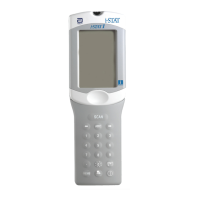Rev. Date: 23-May-12 Art: 716969-00J BNP - 3
testing of BNP could help differentiate pulmonary from cardiac etiologies of dyspnea.
4
Furthermore, the
Task Force of the European Society of Cardiology for the Diagnosis and Treatment of Chronic HF has
included the use of natriuretic peptide (e.g. BNP) testing along with electrocardiography and chest x-rays in
their guidelines for the diagnosis or rule out of HF.
14
The Breathing Not Properly study, a 1586 patient multinational prospective study, validated the clinical
utility of rapid measurement of BNP, used in conjunction with other clinical information, for the diagnosis or
exclusion of CHF in the emergency department15. BNP levels were much higher in patients with subsequent
CHF than in those with non-cardiac dyspnea (675 pg/mL vs 110 pg/mL). A BNP cutoff value of 110 pg/mL
had a sensitivity of 90% and a specificity of 76% for differentiating CHF from other causes of dyspnea,
and a cutoff value of 50 pg/mL had a negative predicative value of 96%. There was a 43% indecision rate
among physicians in the ED trying to make a diagnosis in patients with dyspnea. Had BNP levels been
available to those physicians, the indecision rate would have been reduced to 11%. In multivariate analysis,
BNP levels always contributed to the diagnosis, even after consideration of the history and physical exam.
BNP levels are also raised in patients with left ventricular dysfunction, and the values can be used to assess
the severity of CHF, as they correlate with both New York Heart Association (NYHA) functional class and
patient prognosis.
16
Steg, et al indicated in 2005 that BNP measurement is consistently superior to a single echocardiographic
determination of left ventricular EF in identifying patients with CHF, regardless of the threshold value.
16
Two-dimensional echocardiography was less sensitive than a single determination of BNP in diagnosing
CHF. However, the two variables have marked additive diagnostic value and when combined have a much-
improved accuracy compared to either method alone. This strongly suggests that, where applicable, they
should be used together.
16
Studies also indicate that BNP also has a burgeoning role in the prognostic assessment of patients with
heart failure.
17
BNP is a powerful prognostic indicator for patients with CHF at all stages of the disease and
seems to be a better predictor of survival than many traditional prognostic indicators, such as New York
Heart Association class, serum creatinine values, and possibly left ventricular ejection fraction.
18
The relative
risk of death increases by about 35% for each 100 pg/mL increase in BNP in patients with CHF.
18
Raised
BNP values also predict the survival in patients not known to have CHF, with the risk doubled in patients
with a BNP value >20 pg/mL.
18
BNP has also been shown to predict morbidity and mortality in other cardiovascular conditions, such as
acute coronary syndromes and acute myocardial infarction.
19
ACS patients with increased BNP levels have
a higher rate of cardiac complications and higher mortality post myocardical infarction.
When a panel of neurohormones (including BNP and catecholemines) was measured one to four days after
acute infarction, BNP was the only independent predictor of late ejection fraction (EF <40%) and was the
most powerful predictor of death within four months after infarction.
20
In 2,525 AMI patients, the magnitude
of BNP elevation correlated with mortality, heart failure, and recurrent infarction at both 30 days and 10
months.
8
A strategy of combining EF and BNP improved risk stratification beyond using either alone.
21

